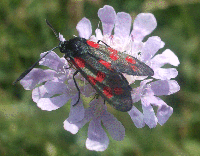|
January |
Skylarks singing to claim territory.
Lapwings can be seen in flocks on arable fields, with the
occasional grey plover. Some plants
found in disturbed ground , such as arable fields, can be found growing
and even flowering at any time of the year. These include
chickweed, Shepard's purse, white deadnettle,
groundsel and daisy. |
|
February |
Rooks starting to become more active around nests in
rookeries. 'Arable weeds': field speedwell start to flower. |
|
March |
Lapwings (also known as peewits) start to
establish territories. |
|
April |
Blackthorn in full blossom. Trees and shrub
starting to come into leaf. 'Arable weeds' including ivy-leaved
speedwell, ribwort plantain and common forget-me-not
start to flower. |
|
May |
Hawthorn flowering.
'Arable weeds' including
poppy common fumitory, white clover and
silverweed starting to flower. |
|
June |
Elder blossoms, dog roses and the honeysuckle pepper the hedgerows along with the flowers of the bramble (blackberry).
'Arable weeds' including bindweed and
redshank start to flower. The rare corncockle,
crested cow-wheat and corn marigold, which have all but disappeared from the countryside,
start to flower. |
|
July |
Greater bindweed and traveller's joy
flowers in the hedgerows. 'Arable weeds' including poppy blooms with other annuals such as scentless mayweed, pineapple weed,
docks, scentless mayweed and white campion, mixed in with barren brome,
a grass with dropping seed heads. |
|
August |
Elderberries ripen and are feasted on by hungry birds such as starlings and blackbirds. Other berries are ripening too, such as hawthorn ('haws'), sloes and rose
hips. |
|
September |
Tree species such as ash, beech and sweet chestnut
are also turning with tinges of yellow, orange and light green tinges.
Conkers start to ripen. Horse chestnut leaves start
to take on autumn colours. |
|
October |
Hazel nuts and acorns ripening, field maple, ash and sycamore
seeds ripening. Trees take on autumn colours. |
|
November |
Most trees and shrubs turned to autumn colours and have,
or will soon, fall. Black bryony stems thread
through the hedgerows, supporting their clusters of fat, poisonous red
berries. Old man's beard seed heads are now fluffy. |
|
December |
Flocks of finches (e.g.
chaffinch, greenfinch and brambling) and flocks of
redwings and fieldfares move across fields seeking seeds,
insects and berries. |
